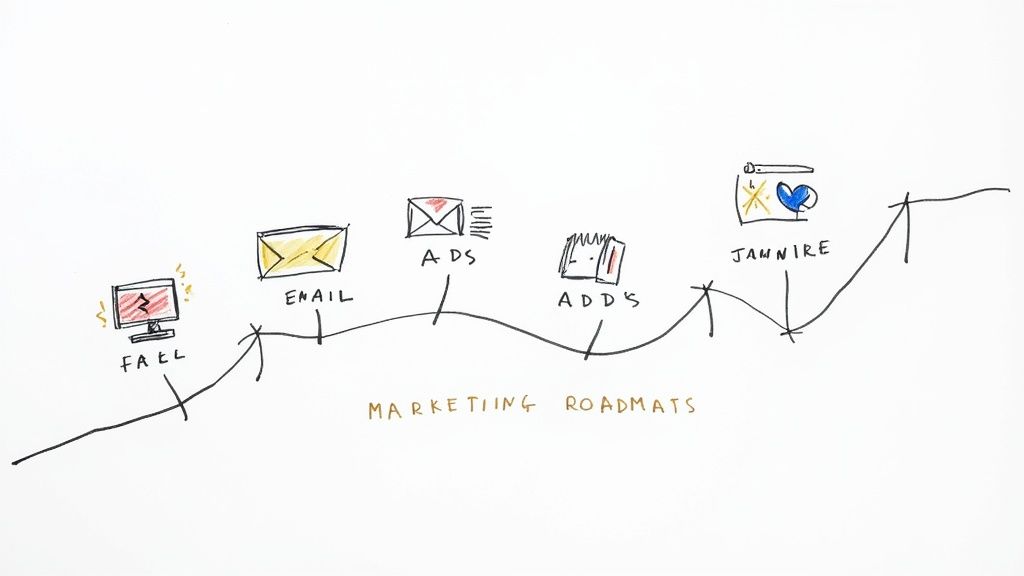Table of Contents
Why Your Product Launch Checklist Determines Market Success
Foundation Research That Actually Predicts Market Success
Market Validation Methods Comparison
Cross-Functional Team Alignment That Actually Works
Go-To-Market Strategy That Cuts Through Market Noise
International Launch Strategy That Scales Successfully
Why Your Product Launch Checklist Determines Market Success
Let's be honest—launching a product without a structured approach is like building a house without blueprints. You might end up with something that looks like a house, but it’s probably unstable, over budget, and full of nasty surprises. In the software world, a product launch checklist is that essential blueprint. It turns a chaotic, high-stakes event into a managed, predictable process. After talking with countless software executives who've overseen hundreds of launches, a clear pattern has emerged: methodical planning is what separates market leaders from products that quietly disappear.
The hidden costs of a disorganized launch are staggering. We're not just talking about a missed deadline or a buggy first release. It's about wasted marketing dollars on campaigns that misfire, engineering teams burning out on last-minute changes, and sales teams left completely unprepared to sell. More critically, it’s about missed revenue windows that, once closed, might never reopen. A competitor can easily swoop in and capture the market while you're still trying to get your teams on the same page.
The Framework for Repeatable Success
A well-crafted product launch checklist does more than just list tasks; it creates alignment and a clear framework for accountability. It forces critical conversations to happen early, making sure that everyone from product and engineering to marketing and sales is working from the same script. This isn't just about managing risk, although that's a huge benefit. You can explore more on managing these uncertainties in our guide on product risk management. A systematic approach is fundamentally about building a machine for repeatable success.
Ready to drive more growth & achieve bigger impact?
Leverage my 25+ years of successes and failures to unlock your growth and achieve results you never thought possible.
Get StartedThink of it this way: top-tier companies don't rely on heroic efforts or pure luck. They rely on proven systems. Industry analysis shows that a structured product launch checklist, often containing 10 to 12 key stages, is standard practice for companies aiming to maximize their market penetration. In fact, sticking to a detailed checklist—from initial validation to post-launch analysis—can increase the odds of launch success by up to 50%. You can learn more about structuring these stages by checking out the findings on successful launch frameworks.
From Chaos to Clarity
Ultimately, the goal is to reduce uncertainty and empower teams to execute with confidence. When every department understands its dependencies and deadlines, the entire organization moves faster and more cohesively. I saw a real-world example of this at a mid-size SaaS company that struggled with three consecutive underwhelming launches. Their products were solid, but their teams were chronically out of sync.
By implementing a rigorous checklist, they transformed their process. Marketing knew exactly when to start building collateral, sales had time to be properly trained, and support was ready for customer inquiries on day one. Their next launch exceeded its revenue target by 40%. This shift wasn't magic; it was the direct result of methodical, systematic planning. Understanding how to use a business process documentation template can provide a solid foundation for building your own checklist and achieving this level of clarity.
Foundation Research That Actually Predicts Market Success
Every great product launch starts long before a single line of code is written. It begins with a deep, almost obsessive, curiosity about the market and the people in it. Far too many companies treat this phase like a simple to-do list: run a few surveys, peek at competitor websites, and call it done. This approach is a fast track to launching something nobody truly needs.
The kind of research that actually predicts success goes much deeper. It’s about uncovering the genuine, unspoken pain points of your customers. The goal isn't just to confirm an idea you already have; it's to challenge it, refine it, and sometimes, realize you need to pivot entirely based on what you learn. Companies that properly invest in this early stage see a huge improvement in sales forecasting and product positioning. You can see how this foundational work connects to the entire launch by exploring more about proven product launch strategies on developmentcorporate.com.
Uncovering Customer Pain Points and Needs
The core of real market research is talking to people. I don't mean sending out mass surveys and hoping for the best. I mean conducting structured, one-on-one customer interviews. Your mission is to get past surface-level feature requests and understand the "why" behind their problems.
For instance, a potential customer might say, "I wish your software had a better reporting feature." A beginner researcher would just note "better reporting" and move on. An expert probes further:
- "Can you walk me through the last time you tried to make a report? What were you trying to accomplish?"
- "Who sees this report? What decision are they making with it?"
- "What happens if you can't get this information? What's the real business impact?"
Ready to drive more growth & achieve bigger impact?
Leverage my 25+ years of successes and failures to unlock your growth and achieve results you never thought possible.
Get StartedThese follow-up questions often reveal the true pain. It might not be the lack of a feature but a broken workflow, a communication breakdown between teams, or a desperate need for real-time data to prevent a costly mistake. That's the gold you're digging for. Try to speak with at least 12-15 prospective customers to start seeing clear patterns emerge.
To help choose the right method for your situation, here's a quick comparison of common market validation techniques.
Market Validation Methods Comparison
A detailed comparison of different market validation approaches, their effectiveness, cost, and timeline requirements.
| Validation Method | Effectiveness Rating | Cost Level | Timeline | Best Use Case |
|---|---|---|---|---|
| Customer Interviews | ★★★★★ (Very High) | Low to Medium | 2-4 Weeks | Deeply understanding qualitative pain points and workflows. |
| Surveys | ★★★☆☆ (Medium) | Low | 1-2 Weeks | Quantifying known issues or gathering demographic data at scale. |
| Landing Page/MVP Test | ★★★★☆ (High) | Medium | 4-8 Weeks | Gauging real-world purchase intent before building a full product. |
| Competitor Analysis | ★★★☆☆ (Medium) | Low | 1-3 Weeks | Identifying market gaps, pricing norms, and positioning strategies. |
| Prototype Testing | ★★★★☆ (High) | Medium | 3-6 Weeks | Validating usability and specific solution concepts with target users. |
As the table shows, Customer Interviews are unmatched for uncovering deep, qualitative insights early on, which is why I always recommend starting there. An MVP test is powerful, but it comes later once you have a clearer hypothesis to test.
Competitive Analysis That Finds White Space
Once you have a solid understanding of customer problems, you need to map out the competitive landscape. This is more than just making a list of competitors and their features. A proper analysis uncovers their blind spots and the "white space" where your opportunity lies. Don't just make a feature-by-feature spreadsheet; create a value proposition matrix.
Create your own analysis that maps out how each competitor positions themselves, their main marketing messages, and their pricing. You’ll often find that most competitors are clustered together, solving the exact same problem for the exact same audience. Your opening might be:
- Targeting an underserved niche: A competitor might focus on enterprise clients, leaving a massive opening for a solution designed for mid-market companies.
- Solving a different part of the problem: While everyone else focuses on one aspect of a workflow, you might discover a bigger opportunity by solving an adjacent, more painful part of it.
- Offering a disruptive business model: If the market is dominated by pricey annual contracts, a flexible usage-based pricing model could be a huge differentiator.
This level of detailed research is a non-negotiable part of a good product launch checklist. It gives you the strategic intelligence to build a product with a built-in competitive advantage, ensuring you’re a clear, compelling solution, not just another voice in a crowded room.
Cross-Functional Team Alignment That Actually Works
A brilliant product can fail spectacularly if your internal teams are operating in silos. You might have the best market research and a killer go-to-market strategy, but if engineering, marketing, sales, and support aren't in sync, you’re headed for an expensive mess. This isn't just about avoiding arguments; it’s about creating a unified force that amplifies your launch. A core part of any product launch checklist is establishing this operational harmony from day one.
Ready to drive more growth & achieve bigger impact?
Leverage my 25+ years of successes and failures to unlock your growth and achieve results you never thought possible.
Get StartedDepartmental tensions are a fact of life. Marketing needs finalized messaging weeks ahead of time, sales wanted customer-ready case studies yesterday, and engineering is trying to squash last-minute bugs. Without a clear system, this friction grinds everything to a halt. The secret isn't to get rid of the tension, but to channel it into productive collaboration. Companies that get this right see their launches accelerate, not stall.

Establishing Clear Ownership and Communication
The first move toward real alignment is to define ownership without creating territorial walls. This starts with a RACI (Responsible, Accountable, Consulted, Informed) matrix for the launch. It might sound like more corporate paperwork, but a well-defined RACI chart is a lifesaver. It clarifies exactly who is doing what, who has the final say, and who just needs to be kept in the loop. For instance, the Product Marketing Manager could be Responsible for creating sales enablement materials, while the VP of Sales is Accountable for their successful use by the team.
This simple act of documentation prevents the all-too-common problem where multiple people think they own a task—or worse, no one does. To make this work, you have to establish a central communication hub. This could be a dedicated channel in Slack, a project in Asana, or a space in Confluence. The tool itself matters less than the discipline to use it. All major decisions, updates, and dependencies must be documented there. This creates a single source of truth and stops critical info from getting lost in email chains.
Building an Accountability Framework
Once ownership and communication are set, the next layer is an accountability framework built on shared success metrics. Instead of each department chasing its own KPIs, align everyone around the launch's main goals.
Here’s a practical way to set this up:
- Product Team: Success isn’t just shipping on time. It's also about hitting initial adoption rates and seeing low critical bug reports in the first 30 days.
- Marketing Team: Success isn't just lead volume. It’s the number of Marketing Qualified Leads (MQLs) that actually convert to sales opportunities for the new product.
- Sales Team: Success isn't just closing deals. It's about hitting a specific revenue target for the new product within the first quarter after launch.
- Support Team: Success isn't just closing tickets. It's about keeping a high Customer Satisfaction (CSAT) score for all questions related to the new product.
When you tie these individual metrics to the bigger launch objectives, you create a system where everyone is pulling in the same direction. For example, if the support team is getting slammed with tickets about a confusing feature, they have a direct reason to give clear feedback to the product team, who is measured on adoption. This connection transforms separate department goals into a shared mission.
Go-To-Market Strategy That Cuts Through Market Noise
After getting your internal teams on the same page, the next piece of your product launch checklist is building a go-to-market (GTM) strategy that actually gets noticed. A brilliant product can fail if its market entry is a whisper instead of a roar. This isn't just about being loud; it's about making the right kind of noise to the right people. Your GTM strategy is the bridge connecting your validated product to a market that’s ready to buy.
Ready to drive more growth & achieve bigger impact?
Leverage my 25+ years of successes and failures to unlock your growth and achieve results you never thought possible.
Get StartedA successful launch depends on a strategy that’s much more than a simple marketing plan. It’s a complete roadmap for market entry, blending product positioning, pricing, distribution, and promotion into a single, unified attack. Without it, you're looking at a disjointed launch where marketing messages don't match up with sales conversations, and neither reflects the product's real value.
Crafting a Compelling Message and Position
The bedrock of any solid GTM plan is your product positioning statement. This isn't just fluffy marketing-speak; it's a sharp, internal-facing declaration that carves out your spot in the market. It must answer three key questions: Who is this for? What problem does it solve? And why is it truly different from everything else out there? Nail this, and every piece of content, from a sales deck to a social media post, will tell the same powerful story.
With positioning locked down, you can build out your messaging framework. This is where you translate that internal statement into language that connects with customers. Think back to the specific pain points you found during your research and hit them directly. Instead of saying your software has "advanced analytics," your message could be, "Stop guessing where your budget is going and get a clear, one-click report on your marketing ROI." This direct, benefit-first language cuts through the usual jargon.
This diagram from HubSpot shows how these ideas work together.
The image makes it clear that a GTM strategy is a flywheel, connecting market intelligence, positioning, and a sales and marketing plan in a continuous loop. It’s a living document, not a one-and-done task.
Choosing Your Channels and Driving Demand
Once your message is sharp, you need to pick the right channels to deliver it. A classic mistake is trying to be everywhere at once. Instead, put your resources where your target audience actually is. Is your ideal customer a C-level executive? Targeted outreach on LinkedIn and sponsored content in industry publications might be your best bet. Are you going after developers? A launch on Product Hunt and a series of technical blog posts could be far more effective.
Beyond paid channels, think about how to create some organic excitement. To really cut through the noise with authentic voices, think about building a solid user generated content strategy. Getting early adopters to share their experiences builds powerful social proof that’s more credible than any ad you could run.
Here are a few core areas to activate:
- Sales Enablement: Give your sales team the tools they need to close deals. This means battle cards detailing competitive advantages, clear product one-pagers, and compelling case studies from your beta testers.
- Demand Generation: Plan your content for pre-launch, launch day, and post-launch. This could include a webinar series, a countdown email sequence, and blog posts that solve related problems for your audience.
- Partner Training: If you rely on channel partners, they need to know the product just as well as your own team. They are an extension of your brand and must be confident advocates.
Ultimately, a strong GTM strategy is a dynamic plan, not a static document. It needs constant feedback and the flexibility to adapt based on how the market actually responds. For a deeper look at structuring this kind of thinking, our guide on a product strategy framework offers some excellent additional context.
International Launch Strategy That Scales Successfully
Taking your product global is a whole different ball game. It’s not just about translating your user interface and calling it a day; it's about fundamentally rethinking your approach to the market. A domestic product launch checklist is complex enough, but an international one introduces layers of regulatory, cultural, and operational challenges that can quickly derail even the most successful products if not managed carefully. The goal isn't just to enter a new market, but to do so in a way that scales without diluting your core value proposition.

This process demands a specialized go-to-market strategy. Simply pushing a one-size-fits-all product globally is a recipe for wasted resources. Data shows that companies failing to localize their launch efforts can see revenue losses between 20-30% compared to those that adapt. On the flip side, a properly executed international launch can boost global market penetration by a staggering 25-40%. You can learn more about what goes into a successful global go-to-market strategy to understand the depth required.
Prioritizing Markets and Navigating Complexity
The first step in a scalable international plan is deciding where to go. Chasing every opportunity at once is a common mistake that fragments development resources and burns out teams. Instead, build a market prioritization framework. This isn't just about market size; it's a balanced view of opportunity versus complexity.
For example, a large market like Germany might seem appealing due to its GDP, but it also comes with stringent data privacy laws (GDPR) and high user expectations for localized customer support. Conversely, a smaller but digitally mature market like the Netherlands might offer an easier entry point with lower regulatory hurdles and high English proficiency, making it a perfect pilot market.
To help you decide, consider building a simple matrix to score potential regions. This adds a layer of objectivity to what can often be an emotional decision.
International Launch Complexity Matrix
This table provides an analysis of key factors that impact international launch complexity and success rates across different regions.
| Region | Regulatory Complexity | Localization Requirements | Market Competition | Success Rate |
|---|---|---|---|---|
| Western Europe | High (GDPR, etc.) | High (multiple languages) | High | Medium |
| North America | Medium (state-level laws) | Low (primarily English) | Very High | High |
| Southeast Asia | Medium (varied by country) | Very High (diverse languages) | Medium-High | Medium |
| Australia/NZ | Low-Medium | Low (English) | Medium | Very High |
| Latin America | Medium (varied) | High (Spanish/Portuguese) | Medium | High |
The matrix highlights that a region like Australia/New Zealand might offer a higher initial success rate due to lower complexity, making it a strong beachhead for further expansion. North America and Latin America also show high potential, though with different challenges.
Ready to drive more growth & achieve bigger impact?
Leverage my 25+ years of successes and failures to unlock your growth and achieve results you never thought possible.
Get StartedOnce you've picked your target markets, the next challenge is localization. This goes far beyond simple translation. True localization involves adapting your product's features, user experience, and even business model to meet local expectations.
Here are a few practical examples of what this means:
- Payment Methods: In many parts of Asia, credit cards are not the dominant form of payment. Integrating local mobile wallets or bank transfer options is critical for conversion.
- Cultural Nuances: An image or color scheme that works well in North America might be offensive or confusing in the Middle East. Your marketing collateral and UI need to be culturally vetted.
- Product Features: In some regions, offline functionality might be a killer feature due to less reliable internet access. In others, integration with a popular local messaging app could be the key to adoption.
The key is to build a core product that is flexible enough to accommodate these regional variations without creating dozens of separate, unmanageable codebases. This often means designing your platform with internationalization in mind from the start, using systems that can easily swap out language files, currency formats, and even specific UI components based on the user's location. This foresight prevents your international growth from becoming a technical nightmare down the line.
Launch Execution When Everything Is On The Line
This is it. After months of planning, research, and cross-functional alignment, launch day turns all your hard work from theory into market reality. This is where your meticulous product launch checklist pays off, but it's also where you need to be ready for the unexpected. No launch goes exactly as planned. The key isn't to prevent all surprises—that’s impossible. It's about building a command center that can handle them with speed and precision.
I once worked on a launch where a critical third-party API we used for user authentication went down just 30 minutes after our go-live announcement. Panic could have easily set in. Instead, because we had a pre-established "war room" protocol, our response was swift. The engineering lead immediately started a rollback to a cached version, marketing paused paid campaigns to limit new user frustration, and the support lead drafted customer communications. We were back online within an hour with a clear message to our early users. This is the reality of launch execution: planned activities combined with agile crisis management.
Your launch day headquarters, whether physical or virtual, is the nervous system of the entire operation. This isn’t just a place for teams to hang out; it’s a decision-making hub where data flows in and directives flow out. Its main purpose is to monitor, communicate, and respond in real-time.
A common mistake is tracking vanity metrics like website traffic. While interesting, these don't tell you if the product is actually working for customers. Focus on the metrics that truly signal health.
- Core Funnel Conversion: Are users successfully signing up, finishing the onboarding, and hitting the product's "aha!" moment? A significant drop-off here is a red alert.
- Error Rates: Keep a close watch on application error logs. A spike in 404s or 500s points to a technical issue that needs immediate attention.
- Key Action Engagement: Are customers using the primary feature you built the product around? Low engagement might mean your value proposition isn't as clear as you thought.
- Support Ticket Volume & Type: What are the first customers asking about? Are the questions about usability, bugs, or pricing? This is raw, unfiltered feedback on your product's clarity.
The first few hours and days provide a firehose of feedback. Someone on your team must be responsible for sorting through this information. Set up a system to categorize feedback into buckets: "Critical Bug," "Usability Confusion," "Feature Request," and "Positive Feedback." This lets you prioritize effectively instead of getting overwhelmed.
For example, a "Critical Bug" that stops users from completing a purchase requires an all-hands-on-deck response. In contrast, a "Feature Request," even a great one, gets logged for the post-launch roadmap. This disciplined approach ensures you’re fighting the right fires and keeping team morale high. Your ability to respond to these early signals sets the trajectory for long-term success, turning a high-pressure moment into a powerful learning opportunity.
The confetti has settled, and the launch day adrenaline is wearing off. Now what? It's tempting to immediately jump to the next big project, but the period after the launch is where the most important learning happens. Your product launch checklist isn't truly finished until you’ve dug into what worked and what didn’t. This is your chance to turn the chaotic data from a market entry into a playbook for future wins.
A solid post-launch analysis makes sure you don't repeat mistakes and that every success becomes a repeatable process.

Conducting a Productive Post-Mortem
First, you need to hold a structured post-mortem meeting. The point isn't to assign blame; it's about getting an honest assessment of the launch. Make sure you invite key people from every team involved—product, marketing, sales, engineering, and support. The goal is to capture both wins and losses with complete honesty.
Ready to drive more growth & achieve bigger impact?
Leverage my 25+ years of successes and failures to unlock your growth and achieve results you never thought possible.
Get StartedI find it helpful to frame the discussion around a few core questions:
- What went so well that we should make it part of our standard process?
- What were the biggest surprises, both good and bad?
- Where did our initial assumptions turn out to be completely wrong?
- Did any communication gaps create friction or delays for the team?
Write everything down. This document becomes a living blueprint that informs your next launch strategy and helps new team members get up to speed. It’s a key part of building an iterative approach to improvement, a topic we explore more in our resources on product management.
Measuring What Truly Matters
Once you have the qualitative insights from your team, it's time to dive into the hard numbers. Go beyond initial vanity metrics like page views and measure performance against the specific goals you set before the launch.
Here’s what to focus on:
- Customer Acquisition Cost (CAC) vs. Lifetime Value (LTV): Did you bring in new customers at a cost that makes sense for the business long-term?
- Adoption of Key Features: Are users actually engaging with the core functions that deliver value? If a tentpole feature has low adoption, that’s a major red flag.
- Customer Feedback & Support Tickets: Look at the tone and volume of incoming feedback. Are you seeing common themes around usability problems or missing features? To really understand what people are saying, check out some of the best social media reporting tools to capture public sentiment.
By systematically reviewing both team feedback and performance data, you create a powerful feedback loop. This process turns every launch—whether it's a huge success or a learning experience—into a strategic advantage. It ensures your next market entry is stronger, smarter, and more likely to hit the mark.
Struggling to turn launch insights into repeatable growth? As a leadership coach with over 25 years of experience scaling software companies, I help executives like you build the systems and strategies for sustained success. Book a consultation with Matthew Mamet today to refine your product strategies and drive tangible results.
Ready to drive more growth & achieve bigger impact?
Leverage my 25+ years of successes and failures to unlock your growth and achieve results you never thought possible.
Get Started



